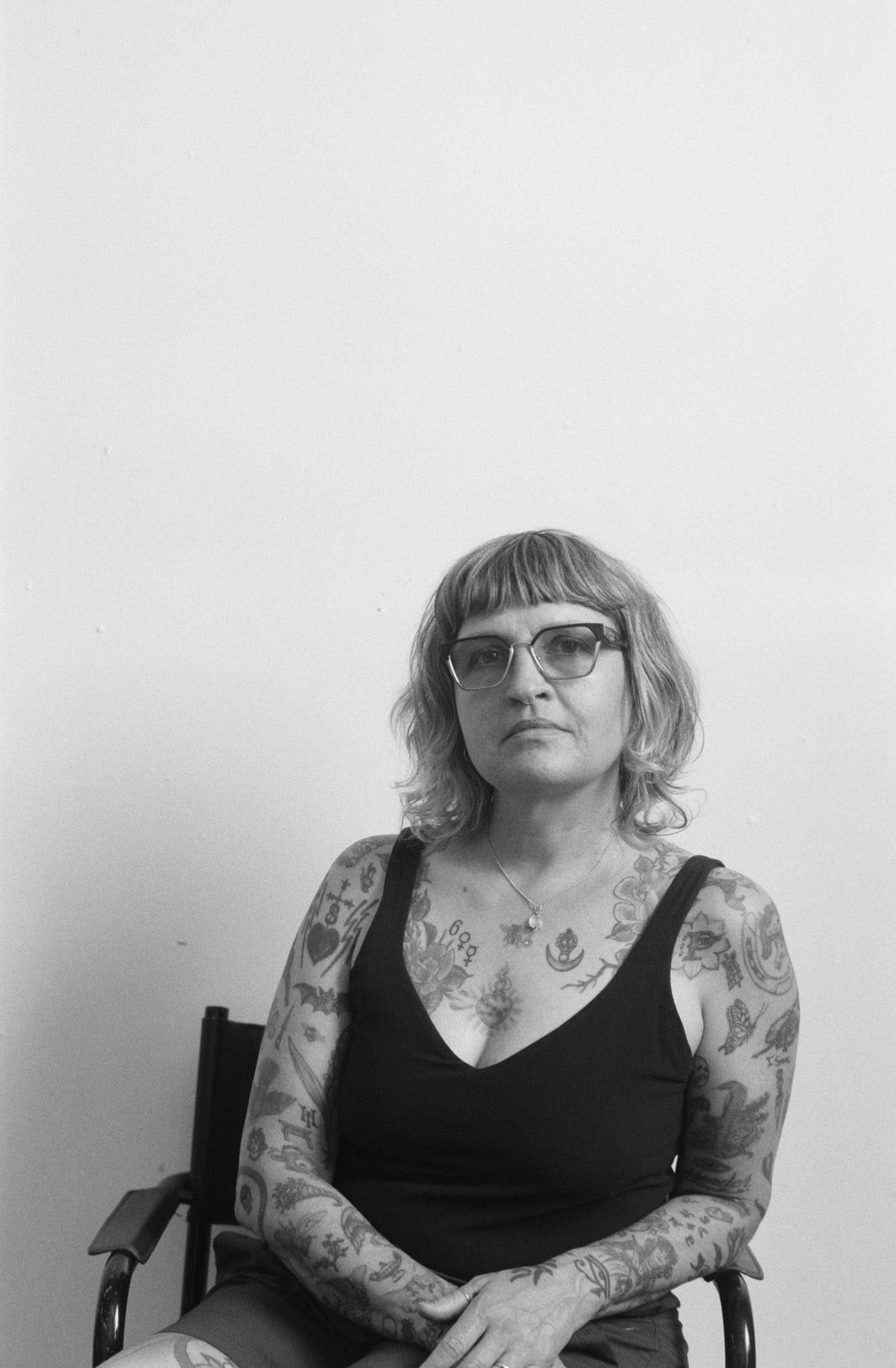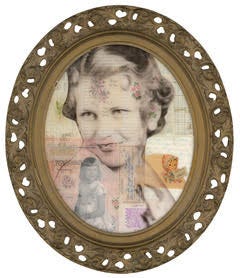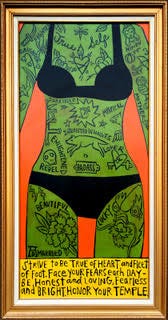Exploring The Art of Grief with Amy Putney-Koenig
The visual artist's new book explores death, grief, and narrative
Grief has shaped Amy Putney-Koenig’s life. But the most salient grief she experienced was not hers at all.
“I don’t have a lot of personal grief. I’ve lost pets. I’ve lost friends, but I see those as kind of natural things,” she said. “My grief comes from this inherited grief.”
She’s referring to the remembering of a death that occurred exactly 456 days before she was born. Her mother’s younger sister, Susan, was killed in a tragic car accident at Ledges State Park. The event colored the rest of Susan’s family members’ lives, grief and anger “[hanging] around the house like smoke from my mom’s friend’s cigarettes.”
That line comes from Amy’s forthcoming book, The Art of Family Tragedy and How to Be Amazing Anyway, an adaptation of a visual art show that explored her aunt’s death through painting and collage.
Through transforming this exhibition into an art and activity book, Amy was able to expand on the narrative that shaped her childhood and the artist, caregiver, and mother she has become today. And through offering this space for others to connect with grief and death, she hopes they, too, can find a space of healing and grace that will carry them through until the beautiful end.
“I never let myself be mad at my mom for telling me she wanted to die and terrifying me as a child. Working on this has let me be mad at her and then release that grief.”
Grasping and Releasing
Amy feels comfortable with the act of storytelling. She’s long used painting and collage-making to create layered, emotional narratives.
“I’ve been doing the same art all my life. I’ve always loved painting and drawing, and in classes I’d insist on doing things my own way,” she said.
That insistence developed into a unique style. Her painting has a punk-rock edge, a nod to the power in femininity and individuality. She hated turning in a flat photograph in a photography class, so she began creating collage by incorporating antique papers and found photographs.
She became enamored with the idea of building a story with items from other people’s lives, feeling the weight and spirit in each photo and trinket that once meant something to someone else. She was eventually given a box of family mementos that included items from Susan’s death. It felt like some inherent part of her story she didn’t understand was finally being revealed.
“This was just something I’d heard and something that my mom suffered from,” Amy said. “It was a story I knew my whole life, but I didn’t know we had proof.”
These items were the foundation to her show, The Art of Family Tragedy and How to Be Amazing Anyway, which premiered in 2012. She was working through the darker parts of her childhood, understanding the why behind a life of substance abuse and mental illness for her mom. How she was made to receive this grief, for a person she never had the chance to meet, without a choice.
“This work has really cracked me open,” she said. “I never let myself be mad at my mom for telling me she wanted to die and terrifying me as a child. Working on this has let me be mad at her and then release that grief.”
The Art of Remembering
It’s been 12 years since Amy originally displayed her art work exploring her mother’s sister’s death. She felt the story, and its universal ideas around how we deal with death, needed more space.
“It felt like this universal story, within it this grief and sadness. I wanted to tell this story so I can let go of the tragedy part of it so this child isn’t only remembered by her death,” she said. “I knew it could be told with words because I’d been repeating it over and over at my shows.”
Her workbook shares chapters of her journey through her childhood, growing up with her struggling mother and her own experiences with addiction, and how she worked to transform that anger and sadness around Susan’s death once she became a mom herself.
An activity follows each chapter that allows the reader to create something themselves. Their own collages using antique photographs, a playlist, a cozy space within which they feel safe and settled. Amy wanted to get readers creating something to support them as they interact with this heavy story.
“It’s really easy in a really busy world to sort of scattered life where we’re everywhere at once. These are moments of calling yourself into your whole body and see this magical creature that you are,” she said.
Art continues to help her regulate her own emotions, filter these darker parts of life through a point of view that centers the possibility of joy.
“This [work] is a love letter to my family, bringing in love for their grief and then also saying, ‘we’re going to let it go here.’ Instead of living with this resentment and grief, we can remember that she was magical and brilliant and lovely,” she said.
“Unraveling my family’s tragedy cleared a path past negativity. I began to see sadness as an opening for deeper connections. In witnessing death, I discovered the art of forgiveness.”
Peace in Death
Amy feels like she’s seen the worst that death can do to a person that continues living.
She also believes the worst is not inevitable.
“I think everyone holds grief differently,” she said. “My mom lived in that grief. In my perception, she spent more time with the dead than she did in the living.”
She decided to turn her own grief journey into service after mother passed away in 2018. She became a hospice volunteer, and later an End of Life Doula. She offers non-medical services and support to those nearing the end of their lives and their families, helping them shape the experience into a more peaceful, unintimidating process.
“I knew I could do this, because I felt like I had faced the worst,” she said. “I can help others face a time where it’s their worst day and their worst imaginable thing happening.”
Her art practice and her end of life work are intimately connected. She strives to bring peace to transformations, to give space to whatever we may feel and provide a channel to move forward.
After witnessing the destruction wreaked by grief in her mother’s life, she wants to help as many people as she can feel more comfortable with death. Look death in the eye, and see it as a beautiful transition into another state of being.
“We’re making it not so sterile and this scary, rushed away thing,” she said. “We can soften our grief for being present for this.”
Connecting Through Grief
The release reception for The Art of Family Tragedy and How to Be Amazing Anyway will be held in the Alex Brown Foundation Studio in Mainframe Studios on Saturday, August 24th, from 6:00-8:00 pm. Along with the books, she’ll display some of the art from the original show.
Amy will also be at Slowdown Coffee Co. in Highland Park on Wednesday, August 28, from 6:00-7:45 pm for a conversation around the book and the topics surrounding her work.
In welcoming in her community, she hopes readers may find hope in the path she walked while she worked through her family’s story, which she wrote about in the introductory chapter:
“Unraveling my family’s tragedy cleared a path past negativity. I began to see sadness as an opening for deeper connections. In witnessing death, I discovered the art of forgiveness.”
Is there a Midwest Creative you think more people should know about? Let me know in the comments and I’ll connect with them.
The Midwest Creative is a proud member of the Iowa Writers Collaborative. Please consider a subscription to my brilliant colleagues’ work to support storytelling across the state of Iowa. All of these authors provide content for free, with paid subscription options. Pick one or more, and help sustain this movement.







